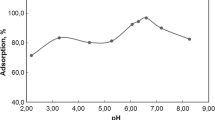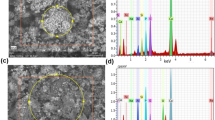Abstract
This study examines the adsorption isotherms, kinetics and mechanisms of Pb2+ sorption onto waste cow bone powder (WCBP) surfaces. The concentrations of Pb2+ in the study range from 10 to 90 mg/L. Although the sorption data follow the Langmuir and Freundlich isotherm, a detailed examination reveals that surface sorption or complexation and co-precipitation are the most important mechanisms, along with possibly ion exchange and solid diffusion also contributing to the overall sorption process. The co-precipitation of Pb2+ with the calcium hydroxyapatite (Ca-HAP) is implied by significant changes in Ca2+ and PO4 3− concentrations during the metal sorption processes. The Pb2+ sorption onto the WCBP surface by metal complexation with surface functional groups such as ≡ POH. The major metal surface species are likely to be ≡ POPb+. The sorption isotherm results indicated that Pb2+ sorption onto the Langmuir and Freundlich constant q max and K F is 9.52 and 8.18 mg g−1, respectively. Sorption kinetics results indicated that Pb2+ sorption onto WCBP was pseudo-second-order rate constants K 2 was 1.12 g mg−1 h−1. The main mechanism is adsorption or surface complexation (≡POPb+: 61.6%), co-precipitation or ion exchange [Ca3.93 Pb1.07 (PO4)3 (OH): 21.4%] and other precipitation [Pb 50 mg L−1 and natural pH: 17%). Sorption isotherms showed that WCBP has a much higher Pb2+ removal rate in an aqueous solution; the greater capability of WCBP to remove aqueous Pb2+ indicates its potential as another promising way to remediate Pb2+-contaminated media.






Similar content being viewed by others
References
Benedetti, M. F., Milne, C. J., Kinniburgh, D. G., Vanriemsdijk, W. J., & Koopal, L. K. (1995). Metal ion binding to humic substances application of the nonideal competitive adsorption model. Environmental Science and Technology, 29, 446–457.
Chaala, A., & Roy, C. (2003). Recycling of meat and bone meal animal feed by vacuum pyrolisis. Environmental Science and Technology, 37, 4517–4522.
Deydier, E., Guilet, R., Sarda, S., & Sharrock, P. (2005). Physical and chemical characterization of crude meat and bone meal combustion residue: waste or raw material. Hazardous Materials, 121, 141–148.
Elliot, J. C. (1994). Structure and chemistry of the apatites and other calcium orthophosphates, Elsevier Science B.V., Netherlands, ISBN 0-444-81582-1.
Kalmykova, Y., Stromvall, A. M., & Steenari, B. M. (2008). Adsorption of Cd, Cu, Ni, Pb and Zn on Sphagnum peat from solutions with low metal concentrations. Hazardous Materials, 152, 885–891.
Laperche, V., Logan, T. J., Gaddam, P., & Traina, S. J. (1997). Effect of apatite amendments on plant uptake of lead from contaminated soil. Environmental Science and Technology, 31(10), 2475–2753.
Laperche, V., Traina, S. J., Gaddam, P., & Logan, T. J. (1996). Chemical and mineralogical characterizations of Pb in a contaminated soil : reactions with synthetic apatite. Environmental Science and Technology, 30(11), 3321–3326.
Levenspiel, O. (1974). Chemical reaction engineering. New Delhi, India: Willey East Priv.
Lewis, J. (1995). The use of bone charcoal in the treatment of rural water supplies. Journal of the Chartered Institute of Water and Environmental Management, 9, 385–395.
Misra, D. N. (1984). Adsorption on and surface chemistry of hydroxyapatites. New York: Plenum.
Nriagu, J. O. (1972). Lead orthophosphates: I. Solubility and hydrolysis of secondary lead orthophosphate. Inorganic Chemistry, 11(10), 2499–2503.
Nriagu, J. O. (1973). Lead orthophosphates: II. Stability of chloropyromorphite at 258°C. Geochimica et Cosmochimica Acta, 37, 367–377.
Nriagu, J. O. (1974). Lead orthophosphates: IV. Formation and stability in the environment. Geochimica et Cosmochimica Acta, 38, 887–898.
Singh, S. P., Ma, L. Q., & Hendry, M. J. (2006). Characterization of aqueous lead removal by phosphatic clay: Equilibrium and kinetic studies. Hazardous Materials, B136, 654–662.
Strawn, D. G., & Spark, D. L. (2000). Effects of soil organic matter on the kinetics and mechanisms of Pb(II) sorption and desorption in soil. Soil Science Society of America, J64, 144–156.
Suzuki, T., Hatsushika, T., & Miyake, M. (1982). Synthetic hydroxyapatites employed as inorganic cation-exchangers: Part 2. Chem. Soc., Faraday Trans, I, 78, 3605–3611.
Takeuchi, Y., & Arai, H. (1990). Removal of coexisting Pb2+, Cu2+, and Cd2+ ions from water by addition of hydroxyapatite powder. Chemical Engineering of Japan, 23(1), 75–80.
Takeuchi, Y., Suzuki, T., & Arai, H. (1988). A study of equilibrium and mass transfer in processes for removal of heavy metal ions by hydroxyapatite. Chemical Engineering of Japan, 21(1), 98–100.
Wu, J., Laird, J. A., & Thompson, M. L. (1999). Sorption and desorption of copper on soil clay components. Journal of Environment Quality, 28, 334–338.
Xu, Y. P., Schwartz, F. W., & Tralna, S. J. (1994). Sorption of Zn2+ and Cd2+ on hydroxyapatite surfaces. Environmental Science and Technology, 28, 1472–1480.
Acknowledgments
This study was supported by the Korea Ministry of Environment as the GAIA (Geo-Advanced Innovative Action) Project (No. 173-091-003)
Author information
Authors and Affiliations
Corresponding author
Rights and permissions
About this article
Cite this article
Cha, J., Cui, M., Jang, M. et al. Kinetic and mechanism studies of the adsorption of lead onto waste cow bone powder (WCBP) surfaces. Environ Geochem Health 33 (Suppl 1), 81–89 (2011). https://doi.org/10.1007/s10653-010-9357-z
Received:
Accepted:
Published:
Issue Date:
DOI: https://doi.org/10.1007/s10653-010-9357-z




